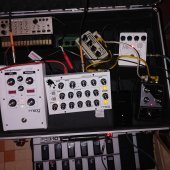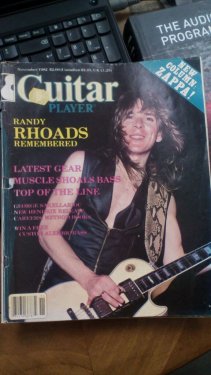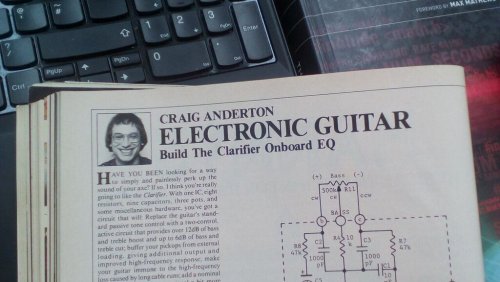-
Posts
1,357 -
Joined
-
Last visited
-
Days Won
1
Posts posted by Gswitz
-
-
Mine auto changes to the correct Hz matching the project unless some other application (like another Daw) has it locked to a different rate.
-
The shelf can raise or lower the gain of the shelf. I thought the word shelf just mean that it was a flat line that ran from some point to the end of the audible spectrum (or that carried by the hardware).
My sub does have a knob for adjusting the cross-over point and another for the gain. The speaker cables leave the sub and go to the speaks after the cross-over.
I'm not sure why a sub would be a HPF. Perhaps what is sent to the speaks is high-passed and what is carried by the sub is low-passed, but to me this is the definition of using a cross-over.
-
-
It occurs to me that a sub with a crossover is really a low shelf with a fixed q, adjustable frequency and gain.
Am I thinking of this correctly?
-
I made and updated video. Actually I caught a bug on the video related to flipping between projects fast. At least I think it's a bug. Anyway, the idea is captured.
-
The efficiency is important, but so is my ability to come back and make changes later.
At 2 hours per song, a thirty song night is 60 hours of mixing. At 4 hours a song, 120 hours.
Being efficient means more listens before I move on.
Having a different project for each song means that as the band listens or a car-listen i can come back and make changes without impacting any other song.
Space is minimized as well. Once mixed, I can delete the master project because the per song projects have all the audio.
Those video bounces aren't hard but they are slow. 10 minutes to save a video, 30 minutes to upload to YouTube. When I change the mix, I want to do it again.
-
This video was from 2013 and my process today is a bit better. See above text.
-
My actions are very memorized.
I load @4 hours of sixteen tracks into a single master sonar project. The last song done is obvious because it was normalized.
I mark and split clips before and after the song I'm going to work on.
I select all between markers (by select all then clicking the ruler between the markers) and bounce to clips.
I select all between markers and normalize to -3 dB peak.
In windows explorer, I copy the last song folder and rename the project file and folder to the name of the new tune.
I open the new project and i see all the audio and settings for the last song.
Select all and delete twice to ensure I get it all regardless of whether focus was on clips.
Save and close.
Delete all audio from the audio folder for the new song.
Re open the new project.
Paste all audio in to the new protect from master project.
Move the now time to the middle of the song and set the tempo by tapping so i have it for tempo sync delays.
Do volume and gain automation on all vocal channels. Any that have no vocals get muted.
Manually remove silence from Tom tracks by splitting around the hits and muting the clips with no hits. I drag the fade arms in on the beginning and end of the clips.
If i want drum augmentation, I use audio snap and adjust percentage until hits match playing. I usually listen through, enabling and disabling transients. Copy midi and paste into drum synth midi track. I sometimes do this for kick or snare. Rarely do i do it for toms.
I have and old video that might be a little dated for this process.
Finally i listen and adjust levels, measuring peak on the master bus and level in the rme digicheck ebu meter.
I might raise guitars during leads.
If I'm hitting my ebu level... -12 or -14 and not limiting, i back off compression until i use all the headroom. Conversely, if the limiter is hitting too hard and i can hear it, i apply mspectral compressor (Multiband compression) to tighten the mix before the limiter.
-
I record bands and mix down song after song, basically using the last song as a template for the next. I copy the project, delete the audio from the last song and paste in the normalized audio for the next song.
Adjusting drums so the different toms are at the right relative volumes to each other can be a challenge since all the toms are not always hit hard so normalization changes relative volumes. Sometimes a vocal that should be more in the background is too loud. I twiddle the faders until I get it close to what I want and call it a day.
Like a goldfish lapping a small tank and re-discovering the same castle again and again, today I noticed that the background noise on the Toms can be a guide for how to set the level relative to each other, then move the volume for the toms as a group to the right place. This helps keep me from over emphasizing one tom randomly because it isn't hit very often.
This may be obvious to everyone already, but today I felt like it was useful and not something I think I've ever put into words.
This is the mix I'm working on...
http://gswitz.blob.core.windows.net/tunes/20181216_Roadhouse.html
-
2 hours ago, Soundwise said:
I use CbB to make music, test gear and virtual plugins, make demos.
I use REAPER to learn songs, following them by ear and to practice before the rehearsals/live playing.
I also have SO4, Samp X3, Cubase 8LE but almost never use 'em due to uncomfortable workflow and some things that bug me in a bad way (including software bugs).
You're a star, soundwise!
-
I like to record others mainly. I enjoy playing guitar but I don't spend much time recording me playing guitar.
I spend a lot of time bouncing down recordings made outside my house (garages, bars, coffee houses). It's been a fun journey learning about mics and fx and balance.
It's like a long term ears challenge to learn to get mixes tight quickly enough that you finish before you move on.
-
 1
1
-





Sub w/ crossover == low shelf ??
in Cakewalk by BandLab
Posted · Edited by Gswitz
Ah yes. That's true. I understand. I wasn't designing the cross-over. More I was realizing that the cross-over frequency is like a shelf frequency and the cross-over gain like a shelf-gain for listening purposes. In other words, the sub with the volume knob and sweepable frequency for the cross-over ends up behaving like a shelf for the listener. Obviously the sound comes from a different place.
I remember being taught that it didn't matter where the sub is because you can't tell where bass comes from. That is entirely wrong imho. Why do people say that?